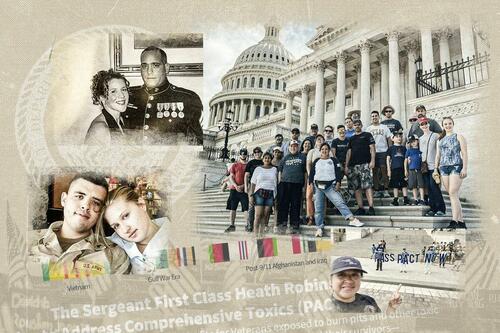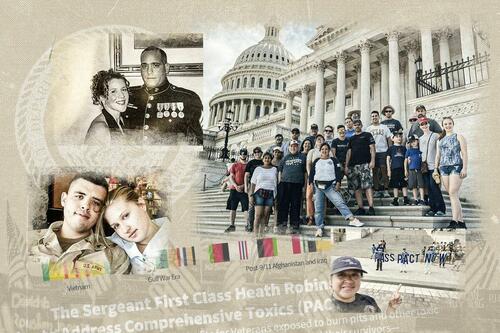2 Years After Burn-Pit Law, Veterans See Improvements But Challenges Persist
Authored by Ryan Morgan via The Epoch Times (emphasis ours),
It’s been nearly five years since Gina Cancelino lost her husband—U.S. Marine Gunnery Sgt. Joseph Cancelino—to his battle with cancer.

She, like many other military spouses and family members, struggled to understand what caused her husband’s illness when it first manifested. Eventually, they began to realize it likely had to do with the open-air burn pits the U.S. military used for years to dispose of plastics, electronics, refuse, and medical waste during deployments throughout the Middle East and parts of Africa.
Gina Cancelino began her search for answers even before her husband’s death and filed multiple claims for benefits as a surviving spouse after his death. She saw one claim denied in the spring of 2021, and another in July 2022 before the Department of Veterans Affairs approved her third request in January 2023.
What changed between her second and third claims was that Congress had passed and President Joe Biden had signed the Honoring our Promise to Address Comprehensive Toxics (PACT) Act in August 2022.
A Journey of Advocacy
The PACT Act’s passage followed years of advocacy by some of the very same veterans and family members directly affected by illnesses from exposure to burn pits and other sources of toxins. One group at the forefront of this advocacy effort has been Burn Pits 360.
Retired U.S. Army Reserve Capt. Le Roy Torres and his wife Rosie Lopez Torres formed Burn Pits 360 after Mr. Le Roy returned from a 2007 deployment to Iraq with difficulty breathing. He was eventually diagnosed with constrictive bronchiolitis and brain injuries resulting from exposure to toxins, but he and his wife faced challenges getting the VA to accept that his illness was service-connected and that the department had an obligation to support him.
“What really forced us into this journey of advocacy was just basically us dealing with our own injustice,” Rosie Lopez Torres told The Epoch Times in a recent phone interview.
Burn Pits 360 formed in 2009 as a way to connect with other veterans facing similar struggles and to organize the advocacy effort. The advocacy group worked for another 13 years before the PACT Act passed, partnering with other veterans organizations, meeting with lawmakers, and repeatedly returning to Capitol Hill as Congress took incremental steps to address the illnesses veterans faced.
Since the PACT Act’s passage, the VA has established a presumption of a service connection for 23 cancers and respiratory illnesses veterans have experienced after deployments to 16 Middle Eastern and African countries since the Gulf War in 1990, and following the 9/11 attacks. The VA also added new service-connection presumptions for illnesses veterans have encountered after being exposed to a chemical defoliant known as Agent Orange during the ‘60s and ’70s.

Within about a week of the PACT Act’s passage, Ms. Cancelino began preparing her third claim for survivor benefits for her and her two children. About five months later, the VA had approved the claim and eventually began paying out a survivor benefit for her family.
When he learned of his late-stage cancer diagnosis in 2017, Mr. Cancelino had been primarily worried about making sure his family would be cared for and would receive some of the benefits he earned through his years of military service. Ms. Cancelino told The Epoch Times that her late husband would be very proud to know that his family is being cared for after his death, and that his case can “maybe make somebody else not have to go through all of the things that we had to go through.”
In May, the White House assessed the VA has processed more than 1 million PACT Act-related claims, approving about $5.7 billion in benefits to veterans and their survivors.
“Generations of patriots have stood on the frontlines of freedom, each one a link in a chain of honor stretching back to our founding days,” President Biden said in a May 21 address. “Just as you have done your duty to America in the past—we’re now, finally, beginning to do our duty to you.”
Zero Percent Disability for Some Cases
While constrictive bronchiolitis is one of the conditions addressed under the PACT Act, some veterans don’t see much benefit after processing VA claims for that illness.
Constrictive bronchiolitis occurs when fibrosis, or scar tissue, compresses the small airway branches of the lungs.
The current VA guide for assessing disability ratings from service-connected illnesses and injuries bars evaluators from combining constrictive bronchiolitis with other respiratory conditions to determine a higher disability rating. In turn, some VA evaluators may record in a veteran’s file that their constrictive bronchiolitis is service-connected, but that their condition warrants a zero percent disability rating, granting them no compensation.
Le Roy Torres, whose experiences helped kickstart Burn Pits 360, is just one of those veterans still struggling with how the VA’s rating system addresses constrictive bronchiolitis.
“The VA still hasn’t fixed the issue of the one lung disease that started this movement,” Rosie Lopez Torres said of her and her husband’s experiences since the PACT Act passed.

Paul McMillin, who deployed to Iraq with the Army and National Guard and who’s dealing with constrictive bronchiolitis, has been able to get some VA benefits for other respiratory illnesses he’s experienced. He’s hoping a change to the constrictive bronchiolitis rating guide will upgrade his disability rating after undergoing invasive thoracic surgery in 2015 and continuing to have troubled breathing ever since.
“We’re definitely not at the end of that road yet, and I think it’s fair to say that for most of us who have served, all we want is just to be treated with dignity and as people,” Mr. McMillin told The Epoch Times. “And I don’t think that that’s too much to ask at Veterans Affairs.”
Sixteen Senate Democrats and Sens. Angus King (I-R.I.) and Bernie Sanders (I-Vt.) addressed VA Secretary Denis McDonough in an April letter, urging him to expedite a new disability rating guide for constrictive bronchiolitis.
“Veterans have waited decades for benefits and recognitions for health conditions related to their toxic exposure,” the lawmakers wrote. “Outdated VA regulations should not deny them earned benefits the PACT Act has provided.”
The Epoch Times reached out to the VA about what changes the department may be considering for rating constrictive bronchiolitis but it did not respond in time for publication.
The Veterans of K2
Many of those still struggling to get their toxic exposure concerns addressed are veterans who deployed to the Karshi-Khanabad Air Base in Uzbekistan from 2001 to 2005. The base, known as K2 or Camp Stronghold Freedom, was built on a derelict Soviet-era military installation and served as a launch point for the earliest U.S. military operations in Afghanistan after the 9/11 attacks. The soil around K2 was contaminated with radioactive material, spilled jet fuel, and asbestos left by those Soviet tenants.
The VA lists Uzbekistan as a presumptive location for burn pits-related illnesses, but K2 veterans face other illnesses more unique to where they deployed, including neurological, autoimmune, endocrine, blood, and bone disorders.
Jennifer Pressey, who deployed twice to K2 with the U.S. Air Force’s 16th Special Operations Squadron between 2001 and 2002, helped run the burn pit at the base while encountering the other toxins endemic to that austere posting.
Read more here…
Tyler Durden
Mon, 07/08/2024 – 21:40

